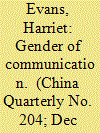| Srl | Item |
| 1 |
ID:
101277


|
|
|
|
|
| Publication |
2010.
|
| Summary/Abstract |
In the flow of the material, cultural and moral influences shaping contemporary Chinese society, individual desires for emotional communication are reconstituting the meaning of the subject, self and responsibility. This article draws on fieldwork conducted in Beijing between 2000 and 2004 to discuss the gendered dimensions of this process through an analysis of the implications of the "communicative intimacy" sought by mothers and daughters in their mutual relationship. What could be termed a "feminization of intimacy" is the effect of two distinct but linked processes: on the one hand, a market-supported naturalization of women's roles, and on the other, the changing subjective articulation of women's needs, desires and expectations of family and personal relationships. I argue that across these two processes, the celebration of a communicative intimacy does not signify the emergence of more equal family or gender relationships, as recent theories about the individualization and cultural democratization of daily life in Western societies have argued. As families and kin groups, communities and neighbourhoods are physically, spatially and socially broken up, and as gender differences in employment and income increase, media and "expert" encouragement to mothers to become the all-round confidantes, educators and moral guides of their children affirms women's responsibilities in the domestic sphere. Expectations of mother-daughter communication reshape the meaning - and experience - of the individual subject in the changing character of the urban family at the same time as they reinforce ideas about women's gendered attributes and the responsibilities associated with them.
|
|
|
|
|
|
|
|
|
|
|
|
|
|
|
|
| 2 |
ID:
181927


|
|
|
|
|
| Summary/Abstract |
The CCP's commitment to gender equality since 1921 has produced vast gains in employment and education for countless women while overlooking established gender hierarchies in family life. Long-term research in Beijing reveals that crossing class, sectoral and generational differences, there is an apparent paradox between women's increasing access to education and employment and their abiding attachment to ideas and practices associated with their roles as wives, mothers and daughters-in-law. A reconfigured “patchy” form of patriarchy is sustained by a dominant discourse of gender difference that naturalizes women's association with the domestic sphere. Unprecedented engagements with international feminism after 1995 introduced new approaches to gender equality. Recently, young feminists from diverse backgrounds have launched public protests targeting expectations of women in marriage and family life, marking a contestation of previous articulations of gender equality. Online platforms are flooded with exchanges about women's empowerment in a market environment that grants them considerable leverage to manage their marital and domestic relationships. The focus of this new generation of feminists on social reproduction signifies a radical departure from the classical Marxist principles underpinning earlier approaches to women's emancipation. Nevertheless, a “patchy patriarchy” continues to characterize widely held gender assumptions and expectations, spanning class and sectoral difference.
|
|
|
|
|
|
|
|
|
|
|
|
|
|
|
|